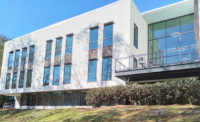Any unused energy from the solar arrays will be put back into the power grid for Pacific Gas & Electric customers, he says, adding that the system will eliminate more than 33,000 tons of carbon emissions.
In addition, the new Exploratorium will have a bay-water system that will take advantage of the bay's natural temperature ranges to cool or heat water. Radiant tubing will carry the water through the facility.
The project's other sustainability features include radiant floors and a system that will allow 16% of the roof water runoff to be reused for toilet flushing. The other 84% will be returned to the bay.
The museum also will have waterless urinals, daylight galleries and low-emitting materials with recycled content and certified wood. It won't use any copper flashing or gutters that might harm shellfish.
The renovation and seismic retrofit of the aged and worn pier foundation proved to be a significant challenge, says Patrick Ryan, a principal with Rutherford + Chekene, San Francisco, the project's structural engineer. For one thing, Ryan notes, a bayside site, with its waves and salt water, is "a fairly severe environment for structures."
He says the seismic retrofit involved the substructure and the transit shed on top of it. Ryan adds, "Seismic retrofit measures included the addition of steel pipe piles to the substructure as well as steel-braced frames, and plywood roof diaphragms to the transit sheds. We also introduced a seismic joint between the main body of the pier and the wharf that runs along the seawall."
Olla of Nibbi Brothers says that substantial work also went into repairing and replacing the piers' existing wood, steel and concrete piles, some of which were so weakened by the elements that "you could put your hand right through them."
"A tremendous amount of work occurred below deck to seismically upgrade the structure—the concrete had all but dissolved away," he says. "The piles had to be chipped of all loose matter and then rebuilt."
To distribute the load for the massive 50-ft-long pile caps, new 72-in.-dia steel piles were "vibrated through the bay mud into solid bedrock," Olla says.
The Exploratorium was founded in 1969 by physicist Frank Oppenheimer, brother of J. Robert Oppenheimer, the "father of the atomic bomb."






Post a comment to this article
Report Abusive Comment